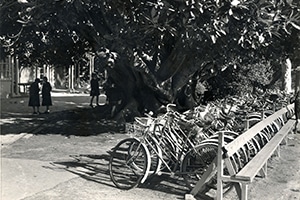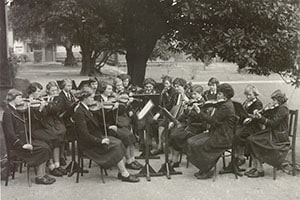1940s – 1950s
Adapting to the changing world
“Today we live in an age of reconstruction and change.” - Lauristonian editorial, 1947
Under the stewardship of Lauriston alumna Miss Elizabeth Kirkhope (1914), successor to the Irving sisters, the School was able to withstand the financial and social pressures of the Depression.
The attitude to girls in paid employment was changing and a range of careers in Kindergarten teaching, nursing and clerical work had become acceptable options. More broadly, there was an expansion in degree choices for Lauriston girls, and as a result there were more science graduates among our alumnae, and the first of our graduates in medicine, dentistry and commerce.
With the outbreak of war in 1939, the School embarked on a program of support for the war effort, raising funds for war-saving schemes, producing garments for the services and collecting materials for recycling. Trenches were dug on the northern side of the hockey field and evacuation drills occurred on a regular basis.
The end of the Second World War saw the Lauriston community ready for renewal and reconstruction. This sense of renewal encompassed all aspects of the School. Miss Kirkhope provided a new flag, and in 1946 William Tainsh composed a new school song with music arranged by music teacher Miss Webb. In 1947 smart berets replaced the wide-brimmed felt hats worn in winter.
The quality of teachers and the growing reputation of Lauriston as academically successful consolidated the School’s place as one Melbourne’s prominent schools. In 1948, 27 girls undertook university studies.
In 1948, the School transitioned from private ownership to a non-profit limited guarantee company, whilst protecting the School’s non-denominational religious status. A new building program was initiated.

Bicycle racks under the Moreton Bay Fig

Irving library 1948

Exterior entrance to Irving Hall 1958

Senior orchestra 1951

Eurythmics 1952


